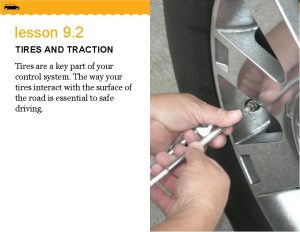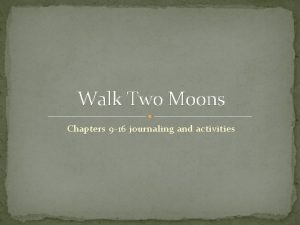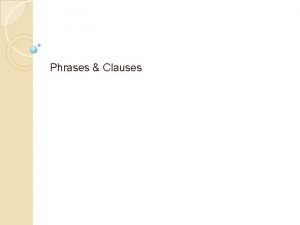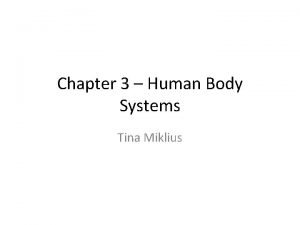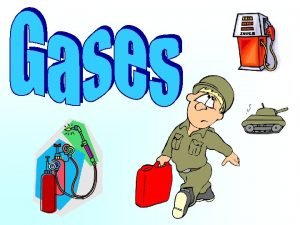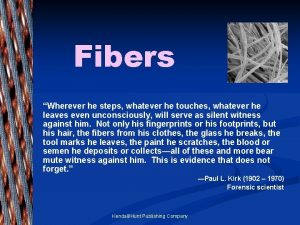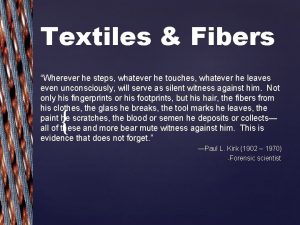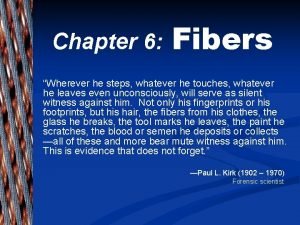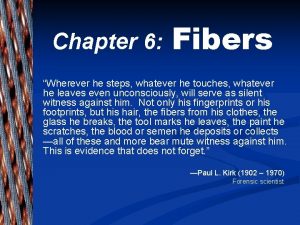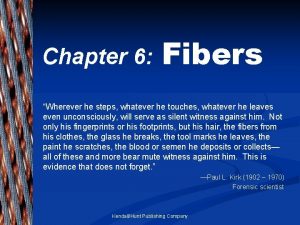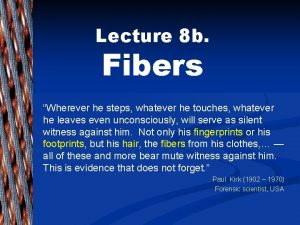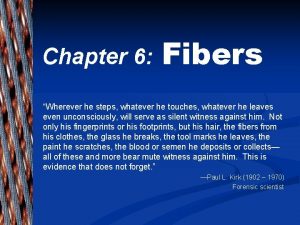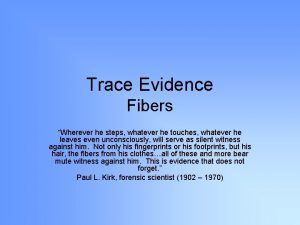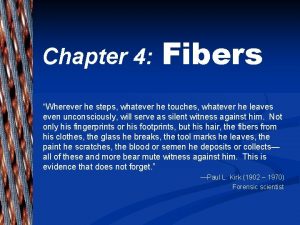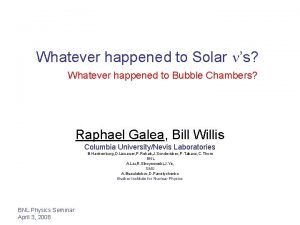Wherever he steps whatever he touches whatever he















- Slides: 15

"Wherever he steps, whatever he touches, whatever he leaves even unconsciously, will serve as silent witness against him. Not only his fingerprints or his footprints, but his hair, the fibers from his clothes, the glass he breaks, the tool marks he leaves, the paint he scratches, the blood or semen he deposits or collects -- all of these and more bear mute witness against him. " —Dr. Edmond Locard Presentation developed by T. Trimpe 2006 http: //sciencespot. net/

What is physical evidence? Physical evidence refers to any material items that would be present at the crime scene, on the victims, or found in a suspect’s possession. Trace evidence refers to physical evidence that is found in small but measurable amounts, such as strands of hair, fibers, or skin cells. Evidence collected from a scene is analyzed and the results used in a crime investigation to prove or disprove the facts of the issue. Source: http: //www 3. sc. maricopa. edu/ajs/crime_scene_technician. htm

Locard’s Exchange Principle "Every Contact Leaves a Trace" The value of trace (or contact) forensic evidence was first recognized by Edmund Locard in 1910. He was the director of the very first crime laboratory in existence, located in Lyon, France. The Locard’s Exchange Principle states that "with contact between two items, there will be an exchange. " For example, burglars will leave traces of their presence behind and will also take traces with them. They may leave hairs from their body or fibers from their clothing behind and they may take carpet fibers away with them. Source: http: //www. virtualsciencefair. org/2004/fren 4 j 0/public_html/trace_evidence. htm

Evidence Examples Paint • Physical and chemical analysis of paint evidence (chips or residue) can indicate it’s class, such as automobile paint, house paint, nail polish, etc. The evidence can be compared to 40, 000 different types of paint classified in a database, which can be used to identify a particular make or model of car or brand of tool. • Paint evidence can also indicate individual characteristics if an investigator is able to find similarities between two samples, such as the color, number of layers, chemical composition, or a physical match between the edges of two paint chips – one from a tool and one from a crime scene. Paint Transfer on a Car Did you know? Most paint evidence submitted to a lab will come from hit-and-run cases involving automobiles. Paint Layers Physical Match of Paint Chip Edges Images: http: //www. state. nj. us/njsp/divorg/invest/criminalistics. html

Glass • Glass particles can be found at various crime scenes, such as breaking and entering, hit and run, vandalism, or murder. • Glass at a crime scene is analyzed to determine its color, surface characteristics, tint, thickness, density, chemical composition, and refractive index (RI). • The results of the tests provide clues about the crime and help investigators connect the evidence to a suspect or other object used in a crime, such as matching glass from a crime scene to a headlight to a suspect’s car. Magnified image of glass fragments The pattern of cracks in a windshield fracture can reveal information about speed, occupant position, and angle of impact. Images: http: //www. rsc. org/images/b 606109 e-300 -(FOR-TRIDION)%20(i. Stockphotos)_tcm 18 -68354. jpg, http: //www. mtcforensics. com/investigation. html

Explosives • Explosive substances can be examined to determine its chemical composition to identify the type of explosive used and its origin. • Traces of explosives found on a suspect’s clothing, skin, hair, or other objects may be matched to explosives from the crime scene. • Materials used to make an explosive device will be compared to evidence found in the suspect’s possession to confirm a match. Image: http: //www. state. nj. us/njsp/divorg/invest/criminalistics. html

Ballistics • Characteristics of ammunition, firearms, and residue are examined to find matches between suspects and the evidence found at a crime scene. • Chemical tests can reveal gunshot residue (GSR) on the hands, face, or clothing of a victim or suspect to indicate how close a person was to a fired gun. • Rifling (grooves) in a gun barrel causes distinctive grooves, indentations and scratches upon fired bullets, which can be matched to the weapon that fired them. • Police are able to search the National Integrated Ballistics Identification System (NIBIS) database to compare markings from bullets, cartridge cases, and shotgun shells to ballistic evidence. Did you know? Caliber (handguns & rifles) or gauge (shotguns) refers to the size of the internal diameter of a gun’s barrel. Investigators can compare the striations on bullets to see if they match. Image: http: //www. geocities. com/j_ksinha/img/mid 1. gif

Fracture Matches • When an object broken, torn, or cut, two unique edges are formed, which are referred to as fracture lines. • These edges can be compared by the naked eye or with microscopes to see if they fit together , which indicates that they may have been part of the same object at one time. • Investigators may compare the edges on pieces of tape, glass fragments, paint chips, pieces of a car from an accident, paper bag, etc. to find possible matches. Images: http: //www. modernmicroscopy. com/main. asp? article=11&print=true&pix=true

Impression Evidence Shoeprints & Tire Tracks • Impression evidence can be photographed, lifted with tape, or cast with plaster to compare to a suspect’s shoes or tires. • Investigators will examine the evidence to identify the brand of shoe or tire based on its tread pattern and other physical features to provide leads in the case. • Shoes and tires will also show wear patterns after being used for a period of time as well as other features (scratches, nicks, and cuts) that can be used to match evidence to specific items. For example, shoeprints can be matched to a suspect based on how the treads on the shoes that are worn down due to that person’s walking style. Bite Marks • Each of the 32 teeth in humans is unique due to age and wear. • Impressions and photographs of bite marks left on a victim, assailant, or other object at a crime scene can often be matched to dental records. Tool Marks • Tiny nicks and chips form on the edges of a tool as it is used, which can be used to identify matches between evidence and suspects. • Tools may also pick up traces of blood or other substances that can be tested or have fingerprints that can be lifted. Images: http: //www. wrongfulconvictionlawsuitdefense. com/uploads/image/28 santos_600. jpg, http: //www. dps. state. ia. us/DCI/Crime_Lab/images/toolmarks. jpg, & http: //www. masterpiecestudios. com/images/171463. gif

Body Fluids • Blood, semen, saliva, sweat, and urine can be analyzed to give investigators information about the crime as well as its victim or the suspect. • Chemicals and ultra violet light can be used at a crime scene to find body fluid evidence. Areas with potential evidence are swabbed, bagged and collected in vials, which are air tight and have a low risk of cross contamination. Examples: Vomit and urine can be used to test for alcohol, drugs, and poisons. Cigarette butts may contain dried saliva. Semen containing sperm is valuable for DNA analysis. Blood can provide DNA evidence and blood spatter can provide clues about the crime. Source: http: //www. virtualsciencefair. org/2004/fren 4 j 0/public_html/trace_evidence. htm Images: http: //www. trutv. com/library/crime/criminal_mind/forensics/chinatown_widow/4. html

DNA • Investigators can extract DNA from almost any tissue, including hair, fingernails, bones, teeth and body fluids. The DNA is used to create a profile that can be compared to profiles from suspects or victims. • CODIS (Combined DNA Index System) is a database maintained by the FBI that is used to find matches to unknown DNA samples from a crime scene. Fingerprints • There are 3 types of fingerprint patterns: arches, loops, and whorls. Investigators also identify unique ridge characteristics in a fingerprint that can be used to identify a suspect or victim. • AFIS (Automated Fingerprint Identification System) is a database used by investigators at local, state, and national levels to search for matches to fingerprints found at a crime scene. Images: http: //biology. arizona. edu/sciconn/lessons 2/Vuturo/vuturo/photos/desmus. gif

Hairs & Fibers • Hairs and fibers may be transferred from the suspect or the suspect’s clothes to the victims’ and vice versa. For example, a suspect may pick up carpet fibers on his shoes or leave hairs behind at a crime scene. • Hairs can be examined to identify their origin, such as human or animal. Hairs with roots intact can be tested for DNA. • Fibers are used to make clothing, carpeting, furniture, beds, and blankets. They may be natural fibers from plants or animals or synthetic fibers that are man-made. Microscopic Image of Hairs & Fibers Dust & Dirt • Dust, dirt, or sand evidence can reveal where a person has traveled and may be picked up at a crime scene or left behind. Microscopic Image of Sand • Investigators examine the samples for chemical composition, pollen, plant material, and other organic matter to find links to a specific crime scene. Images: http: //www. tcamb 1. com/images/hairanalysis. jpg and http: //www. npsg. uwaterloo. ca/resources/images/microscope/Sand%200004. jpg

Skeletal Remains • Forensic anthropologists analyze skeletal remains to determine four characteristics for a victim: age, sex, race, and stature (height/build). Sex - Determined by examining the pelvis, humerus, and femur Age and stature – Determined by analyzing the development of the teeth, bone growth, and the length of specific bones, such as the femur. Race – Determined by analyzing the skull for characteristics that are common among people of different races. • DNA samples can be collected from bone, teeth, and hair to provide clues to a person’s identity. Scientists may also be able to gain clues as to a person’s past, recent injuries, or the cause of death based on bone fractures and other signs of trauma. Source: http: //www. crime-scene-investigator. net/excavation. html Images: http: //www. celticnz. org/images/Feedback/Skull. Skeleton. JPG and http: //www. legacyhealth. org/images/Housecalls/claviclefx. jpg

Wounds • Wounds can often be matched to weapons or tool marks on the weapon. Investigators may also be able to determine the weapon's size, shape, and length. • Analysis of a wound may provides clues to a victim’s injuries, characteristics of the suspect (left-handed, right-handed, height, etc. ), and positions of the victim and suspect at the time of the incident. Questioned Documents • Examiners will analyze a ransom note or other document to find clues to link it to a crime scene or a specific suspect. They will analyze the type of paper used, printing method or handwriting style, and type of ink. • Other unique features, such as watermarks on stationary or indentations made as someone wrote on a page in a notebook, may provide useful clues. Image: (Bottom Left): http: //dofs. gbi. georgia. gov/vgn/images/portal/cit_11783501/81672146 questioned%20 document. jpg

What evidence would you collect? Mock Crime Scene:
 What three things can reduce traction?
What three things can reduce traction? Is charging by induction temporary or permanent
Is charging by induction temporary or permanent Why does sal flinch when ben touches her
Why does sal flinch when ben touches her Zeros where the graph touches but does not cross the x-axis
Zeros where the graph touches but does not cross the x-axis Hannah isherwood
Hannah isherwood What is the reaction of head bumps ball
What is the reaction of head bumps ball Wherever i hang by grace nichols
Wherever i hang by grace nichols Wherever i go andrew chinn
Wherever i go andrew chinn I will follow you follow you wherever you go
I will follow you follow you wherever you go You may sit wherever you like
You may sit wherever you like Shine wherever you go
Shine wherever you go Lead me follow you
Lead me follow you Whatever
Whatever Hello boys and girls or whatever
Hello boys and girls or whatever Lasciviousness definition
Lasciviousness definition Do gases exert pressure on whatever surrounds them
Do gases exert pressure on whatever surrounds them
